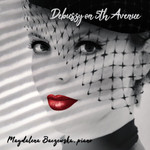|
Back
06/05/2020
“Debussy on 5th Avenue”
Claude Debussy: Estampes, L 100 – Images, L 110 [Book I] – Images, L 111 [Book II]
Magdalena Stern-Baczewska (piano)
Recording: Yamaha Artist Services, Inc., New York City, New York (January 2019) – 41’08
BlueSleep 9200508 – Booklet in YouTube Video format

   
“There is no theory. You have only to listen. Pleasure is the law. I love music passionately. And because I love it, I try to free it from barren traditions that stifle it. It is a free art gushing forth ---- an open-air art, boundless as the elements, the wind, the sky, the sea. It must never be shut in and become an academic art.” Claude Debussy
It’s not hard imagining how liberating these words were to Claude Debussy, and, in particular, those œuvres selected for this album by accomplished pianist, Magdalena Stern-Baczewska. Hailing from Poland, this young lady’s expansive resumé includes that of an au fait harpsichordist, educator and recording artist. Since 2014, she’s also been serving as the Director of the Music Performance Program and Lecturer in Music at Columbia University. What gives her new album a shiny asterisk is her integration of a disklavier and technology that she’s embraced since 2007.
Only a stone’s throw away from Columbia is where we find the elegantly poised Mlle Stern-Baczewska positioned at the keys of a Yamaha DCFX nine foot Concert Grand, a flagship wonderment from the manufacturer’s line. Known for its vast palette of tonality and wide-reaching nuances, it only adds to the revelations the pianist seeks within Debussy’s compositions.
When executing Debussy, music is recorded directly into the piano, allowing over 1,000 key depths and 250 pedal relations to be captured. Later, editing is enabled, permitting external aberrations to be virtually eliminated. The finished product can then be “printed” as a tightly-sealed replication the performer originally intended. Look at the final music output as a pristine rendition, a “player piano” using a ghost host. These are the building blocks which Mlle Stern-Baczewska utilizes to elicit her interpretations.
Yamaha’s vehicle gives strong direction: unadulterated, frank, forthright. But the pianist’s exposed élan also has sensitive touches alongside keen inflections. Prior to this release, Magdalena Stern-Baczewska created three volumes of “Music for Sleep”, teaming up with Dr. Jordan Stern’s BlueSleep®, an organization helping combat sleep disorders. [Remember Philips Classics’ 1995 “Debussy for Daydreaming”?] This musical panacea falls directly into lap of Claude Debussy’s works with its soft-edges and occasionally edgy investments; therefore, the rêve introspectively connects to that of the pianist. Yet she has her own delivery of independence which is compelling.
Mlle Stern-Baczewska’s view points have dollops of surprises. “La Soirée dans Grenade’s” sharp cut offs yielding to strong contrasts between habanera rhythms and Arabic content are intriguingly and appropriately disjunctive. One of the most effective and aqueously permeable pieces is the “Jardins sous la pluie” where the treatment is more pelting and torrential, rather than a mere spritz. Ferocious as it is, the crescendos are lovely and the score pulsates. Interestingly, the final run is capped by a flashy cutoff, rather than the proverbial sustained pedal. Refreshing! Reflecting upon “Reflets dans l’eau”, the pace appears over aggressive, and it loses a bit of the glassy liquidity.
Some musical expressions seem ambitious and forward, as in the “Hommage à Rameau”. Some of her forte clauses overreach and overreact. Conversely, assertions inside “Mouvement” with its metronomic moto perpetuo are brilliantly fashioned, well-executed and dizzying. The pianist courses through “Cloches à travers les feuilles” with assiduousness. Mlle Stern-Baczweska gives Debussy’s hazy moon a moody uncertainly as it hangs in the sky, anchored over the temple in “Et la lune descend sur le temple qui fut”.
There’s a strong and well-integrated density that rests between the left and right hand. This helps paint Claude Debussy’s music with watercolour using more wash than saturation. Thus, her avenues are pleasantly unexpected and refreshing. Upper runs are highly limpid, and the use of the sustained pedal has effective proportions. Inside several caches of slower repose, it’s hard to anticipate the direction of the piece, precisely what Debussy intended. Magdalena Stern-Baczewska reads the mind of the composer.
Audiophiles unaccustomed to the use of a disklavier will find the recording impeccable. But this vacuum can also lose those tangible factors that give a certain “rawness” of the artist at the seat. Make no mistake, however, “Debussy on 5th Avenue” is a stimulating journey.
A beacon of technically flawless achievement.
Magdalena Stern-Baczewska Website
Christie Grimstad
|